The moment you see the first green shoots of your seedlings emerge is always exciting …. even for me (and I’ve done this hundreds of times!). But it can all go horribly wrong if you don’t give your germinating seeds the right aftercare; all too soon your seedlings can go tall and spindly, collapse, turn yellow or rot and disappear. Here are some simple tips to keep your germinating vegetable seedlings healthy and ensure they make it through to sturdy, healthy plants.
How to Care for Seedlings After Germination

Your seeds have germinated.
What to do next?
1. How Much Light Do Germinating Seeds Need?
Germinating seeds need plenty of light; daylight is the best, but this can also be boosted with daylight spectrum bulbs. If you’re using a windowsill in your house, make sure it’s the sunniest one and remember to turn your pots and trays everyday to ensure the seedlings don’t develop a permanent lean towards the light.
2. How Often Should You Water Germinating Seeds?
Most seedling problems are caused by overwatering them; when the compost is too wet diseases flourish, and the seedlings will quickly rot away. If you see the top of the compost turn green, stop watering and let the compost dry out a little before adding more water. The best way to regulate your watering is to put your pot or trays in a bowl or tray with no holes and then water into the tray up to 1cm deep. Let the compost and seedlings absorb the water as they need it and only add water when the bowl/tray is dry.
The other common watering problem is to let the compost get too dry and then only water the top layer of compost. If you do this the water doesn’t get down to the roots and the seedlings will get too dry, wilt and die. You can avoid this problem by using the ‘bottom up’ watering method I’ve described above.
3. How Much Heat Do Germinating Seeds Need?
Vegetable seedlings need different temperatures to germinate (or start sprouting). Make sure you look at the packet to check what’s required for your seeds. Tomatoes, chillies, peppers and other tender or half-hardy vegetables such as cucumber, squash and courgettes need plenty of warmth to get them growing. If you’re growing them on a windowsill indoors this might be enough to start them germinating.
But in the winter and early spring months you might need to boost the temperature by covering the seedlings with a plastic bag or cover that will act as a mini-greenhouse and raise the temperature by a few degrees. If water droplets form inside the cover, dry them off every day to stop the humid conditions encouraging diseases. Once the seedlings have germinated, remove the plastic cover altogether and let them adjust to the room temperature.
4. When to 'thin out' or 'pot on' your germinating seeds?
If you have sown a lot of seeds in a pot or tray and most of them germinate you will then have to thin them out or ‘prick out and pot on’. If you let all the seedlings continue to grow, they will just create a tangle of stem, leaves and roots and strangle each other! So to be kind you need to spread out or remove some of the seedlings and give the remaining ones space to thrive.
5. When should you plant your germinating vegetable seeds outside?
Some half-hardy vegetables will not thrive outside; often chillies, peppers, aubergines and many varieties of tomato and cucumber prefer to grow undercover and benefit from the increased warmth. Check the packet to make sure you’re clear where your particular vegetables prefer to be. This will be affected by how warm it is where you live. I would never put my tomatoes outside in my garden in East Lancashire, but my Mum in Croydon always puts hers outside and gets excellent crops as the average hours of sunlight and temperatures are far higher in her garden.
For hardy vegetables, the time to put them outside is when their roots are well established in their pots, they are at least 5cm tall and the soil is warm enough. Most hardy crops started off inside will be happy being planted out in April. To help them adjust to cooler temperatures, put them outside during the day and bringing them inside at night for at least week. If you have a cold frame, you can put your pots in there and just open the lid during the day and close it at night. Half-hardy crops shouldn’t be planted outside until June, when the frosts have finished and the soil has warmed up.
Remember your seedlings are very young plants and need to be nurtured carefully. By giving them plenty of TLC when they are small, you’ll be rewarded with healthy mature plants and plenty of vegetables to eat.



